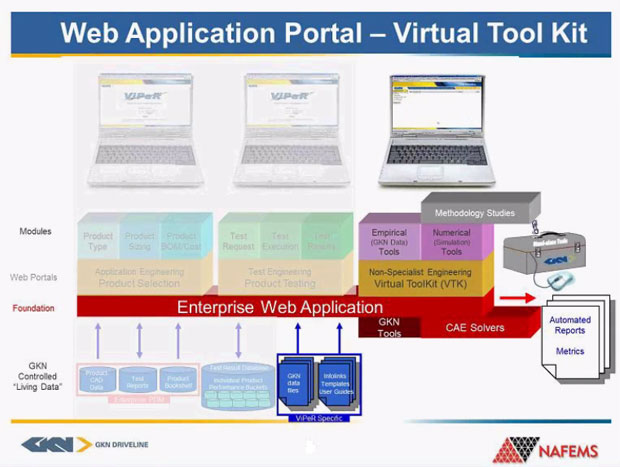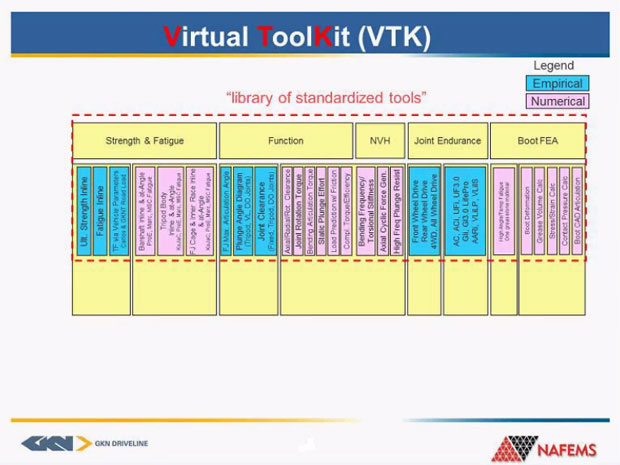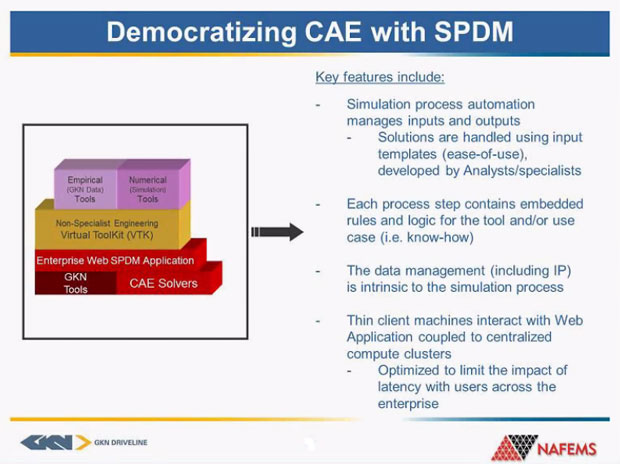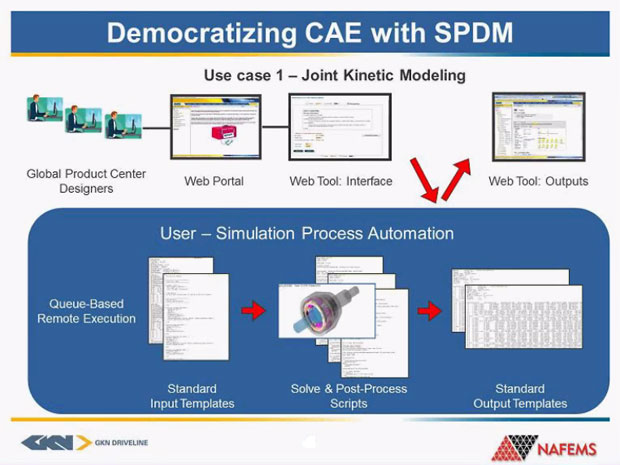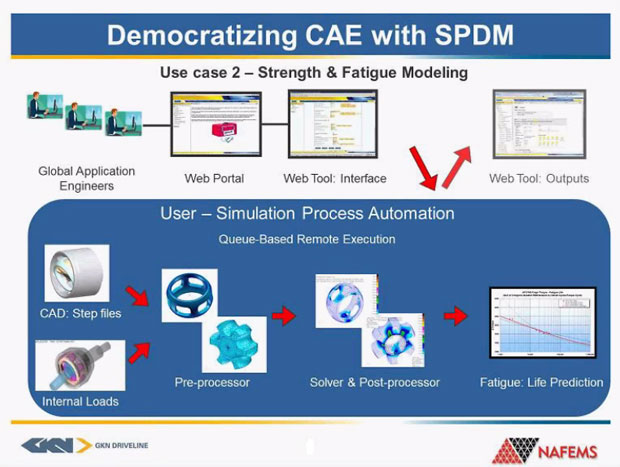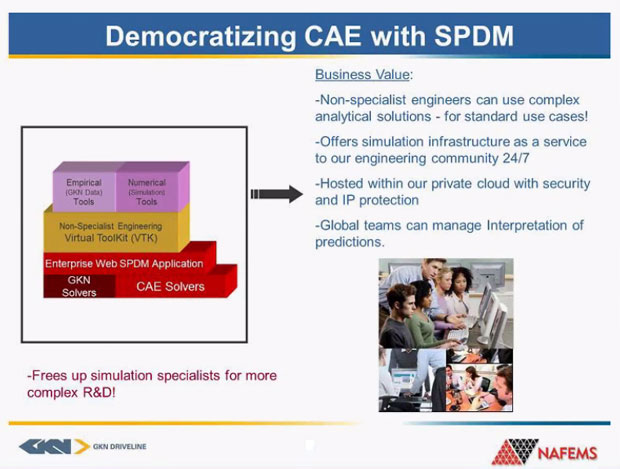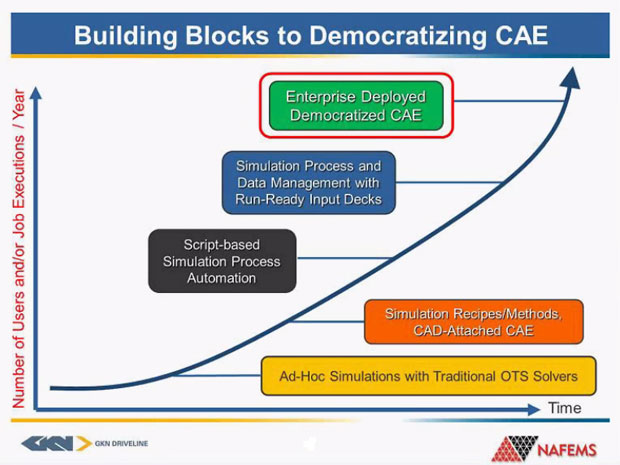
October 27, 2015
By Bruce Jenkins, President, Ora Research
“Democratizing CAE” was the topic of a webinar hosted by NAFEMS on August 27, 2015. Speakers from software, services and engineering/manufacturing firms explored new technologies and methods to embed CAE experts’ “tangible knowledge and intangible judgment into a reusable template, extending this simulation capability throughout the product development team,” in NAFEMS’ words. A highlight of the webinar was a case study by Glenn Valine, Director Engineering IT at GKN Driveline, on “Democratizing CAE with SPDM” (simulation process and data management). GKN Driveline is a leading global manufacturer of automotive driveline components. [A recording of the full webinar is available here: http://nafems.org/events/nafems/2015/democratizing-cae/]
“Our approach,” Valine opened, “was to create a virtual tool kit—one of three web portals inside a bigger system. This is the application that contains our standard calculation tools, both empirical and numerical.”
GKN Driveline’s Virtual Tool Kit contains a broad collection of tools ranging from basic spreadsheets containing dimensional stack-ups, to the state-of-the-art computer-aided analysis solvers. “These GKN best-in-class tools were carefully selected and mutually developed with our worldwide experts to represent globally accepted standard methodologies and recipes within our Driveline engineering enterprise,” Valine explained. “They were not developed at a single site and mandated, and as a result adoption has been extremely positive.”
The standard tools can be accessed globally by the appropriate Driveline engineering staff registered within the system. In addition, GKN’s global CAE experts have direct access to the underlying engines of the tools, enabling them to evolve and extend the tool capabilities for subsequent use cases. “And then further to capturing the standard calculation tools within this tool kit,” Valine said, “process automation has enabled us to make CAE simulation available to the non-specialist users in a targeted and safe way. We called this democratizing CAE with SPDM.”
Democratizing CAE with SPDM has enabled GKN Driveline to achieve solid growth in number of simulation users and executions over time.
Valine described the “building blocks to achieve democratization” within his organization. “At first we had very few analysts making ad hoc simulations with off-the-shelf solvers,” he said. To augment this, the company developed manual recipes and methods for its standard use cases. In addition, its design engineers began using CAD-attached simulations. To accelerate the number of simulations within its worldwide small group of analysts and specialists, the company developed scripts and templates to automate the simulation process. The scripts and templates were then integrated into GKN’s SPDM system, making up the engines of the numerical tools. Finally, a web-based user interface and wizard were integrated within the SPDM system, giving the non-specialists the necessary inputs and templates to enable them to execute the advanced tools.
Valine detailed the key features of the new system. “We’ve got simulation process automation managing the inputs and outputs,” he said. “The solutions are handled using input templates that mimic the non-Analyst way-of-working, that are developed by our analysts and specialists, which enable ease of use. Each process step contains the embedded rules and logic for the tool and/or use case; we refer to that as know-how. The data management, including the intellectual property, is intrinsic to the simulation process. And then thin-client machines interact with the web application coupled to our centralized compute cluster, which is optimized to limit the impact latency with users across our enterprise network.”
Valine then outlined two use cases. The first case “highlights our Joint Kinetic Modeling tool, one of our most frequently used CAE tools in the Virtual Tool Kit, supporting constant-velocity joint development within our Global Product Centers,” he said. “Across all joint types, this tool handles the modeling of internal loads and optimization checks, interconnecting shaft NVH behavior, and functional performance.”
How does it work? First a designer pre-populates standard input templates, then uses a web browser in the application portal, which launches the simulation process. This initiates the Joint Kinetic Modeling solver and post-processor. The results are captured in standard output templates (or reports), and are automatically updated within the web application upon job completion. The results are organized by their applicable products and analysis types, “a key piece of the overall democratized simulation data management within our Virtual Tool Kit,” said Valine.
The second use case highlighted GKN’s Strength and Fatigue modeling tool, which Valine termed “our most extensive example of simulation process and data management, supporting both our global product centers and application engineering, to assess product design features (from product families) to evaluate our customer requirements.” This is done for GKN’s families of joint types in the feature areas of the joint interconnecting shafts and the joint internal components. Again, using a web browser in an application portal, the user is presented with a non-specialist design and application engineering interface, with many of the input parameters auto-populated from flexible GKN XML’s that feed the system. “This ensures that user input parameters start with the correct default data,” Valine noted, and “some of these fields can be edited by the user as needed.”
Then after clicking the submit button, simulation automation launches. First the CAD STEP files are created. Next, kinetic modeling is used to calculate joint internal loads. Then pre-processing begins using GKN’s pre-configured templates. After that, FEA executes. Once the FEA is complete, post-processing automatically begins using pre-configured templates. Last, fatigue modeling handles the fatigue life prediction. “The output of the automation presents life model results in a standard engineering format typical for non-specialist engineers to analyze,” Valine concludes. “This is all executing in the background on a remote compute cluster, allowing the democratized user to conduct other work in parallel.”
As with the first use case, the results are captured within standard output templates (or reports) and automatically updated within the web application portal upon completion. The results are organized by their applicable products and analysis types, Valine said, “which once again is a key piece to the overall Simulation Process Data Management in our Virtual Tool Kit.”
What’s the business value for GKN Driveline? “We now have non-specialist engineers who can use complex analytical solutions for standard use cases,” Valine said. “They do not have to build models or apply loads and constraints. Our Virtual Tool Kit offers a simulation infrastructure as a service to our engineering community 24/7. And it’s hosted within our private cloud with security and IP protection. Then our global teams can manage the interpretation of the predictions, freeing up our simulation specialists for more complex R&D.”
Emphasizing the lessons learned, Valine said, “SPDM and democratized CAE are not bolt-ons to your existing simulation group’s way of working. We see them as a part of a spectrum of approaches to augment simulation opportunities within your company. They’re really about the role in your business, not simply changes in software technology.” Valine noted credit for the later part of this concept is due to Joe Walsh of intrinSIM.
“The engineering analyst has a new and important role,” Valine continued. “You need to define, commonize and validate your worldwide processes and workflows before you start. Your technical experts need to be available for the duration of a project’s deployment and for user support. And you definitely need to design an intuitive user interface and process that mimics the non-analyst way of working, and present it in the terminology that they already speak.”
“Further, don’t underestimate the organizational challenge,” Valine concluded. “In a multi-site, multi-national operation, people will resist and keep to their old way of working. These business transformations will challenge some users. However, the overall effect will be positive for the organization once fully adopted and supported appropriately. And last, it is vital to have executive sponsorship for enterprise standardization projects, because SPDM and democratized CAE, in our experience, are medium- to long-term enablers of intrinsic value within your engineering organization, versus short-term cash generators. They are investments in your engineering organization.”
The webinar that featured this case study was the first in a series of five NAFEMS webinars on democratization of CAE. Following was a webinar on “Expert Knowledge Capture & Reuse” (Sept. 17) and another on “Usability” (Oct. 1). Future webinars in the series will look at “Accessibility” (Oct. 27) and “Next-Generation Computing Architectures” (Nov. 17). The webinars are part of a year-long series titled “Simulation 20/20: The Next 5 Years.” More information: http://nafems.org/about/regional/americas/events/2020vision/
Bruce Jenkins is president of Ora Research, a research and advisory services firm focused on technology business strategy for 21st-century engineering practice. www.oraresearch.com
Subscribe to our FREE magazine, FREE email newsletters or both!
Related Topics







